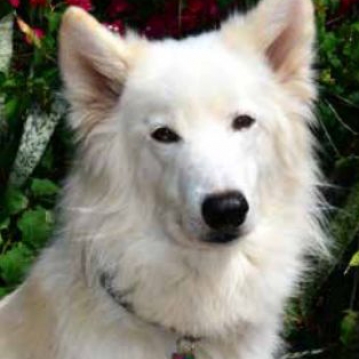
Six rescued Australian Shepherds comprised our pack at one time. Now we are at three, topped with a temperamental Yorkie.
Regardless of age, size, breed, basic pack leadership behavioral principles and techniques should be in place to promote a safe and successful integration. Whether it’s a visiting dog, foster or addition, a new dog should be properly introduced outside, on neutral territory. I like to follow up with a walk together and tire them out.
Hailing from Missouri (likely a puppy mill) Katie was acquired from a puppy store in Palm Beach County. They had never heard of an Australian Shepherd or done any research on the breed/activity. But the condo dwellers liked the way she looked. Sold! Over nine hundred dollars and two weeks later, she was surrendered to rescue. I fostered.
I’ve had dogs my entire life... never one like this. This twelve pound puppy would stare down our benevolent alpha as if to say, "I will battle you to the death over any morsel." From the first day, she was managed (crated, on a six-foot lead and supervised). Separated at meal time, she is served last and not allowed out until all bowls are picked up. "A safe environment for humans and pack members must be created from day one, and maintained. It’s best to be diligent and watchful with behavior, attention and resources," stated behaviorist Edel Miedes of K9 Advisors.
Recently, I was informed of situations where a younger dog was added to households with a single, older dog. No pack management in place. Both families had dogs for decades. In both cases, the older dog was injured (minor for the dogs, traumatic/costly for owners). Within a week, a young dog was found as a stray, spayed and fostered. Within days of being in new home, she made her position known: she was going to rule the roost. Old dog cowered in closet. Trainer was called in, safety measures and boundaries were put in place.
Another consideration: small grandchildren visit this home often. Kids under age seven are known for erratic movement and high noise levels. This can agitate a dog, and compromise their safety, as kids are face-level with a large dog. A child can be disfigured/hurt, and the dog may pay with its life. I always recommend adopting from a reputable rescue, and getting a dog who has been in a foster home for at least a few weeks. This allows for the dog-savvy foster family to discover the dog’s personality/quirks and devote training/attention to any behavioral issues. The first two weeks are like the "honeymoon," dogs can be on their best behavior… and then all hell breaks loose. Let those with experience muddle through that.
The second instance occurred as young dog wanted through the door, before old, slow-moving dog. Young dog began barking excitedly, posturing. Owner got in between, and got bitten. "Anything can be a resource, from a space to a doorway, toys, treats, food and attention from people," added Edel. “It is important for the humans to establish their position as pack leader. This is accomplished through exercises, routines and rules, which form boundaries."
Just like humans, it is a natural for dogs to go through stages. “A younger, or more confident dog will seek opportunities to assert themselves and exert dominance over an older, less energetic (seen as a weak link) pack member," added Edel. Usually it’s noise and body language, but without proper intervention, it can quickly escalate. Always err on the side of caution - for your own safety, those in your household and the dogs. Setting yourself up for success and the joy of residing with dogs begins with proper pack management, establishing yourself as the leader.
Tina Valant-Siebelts is a confirmed dog-o-holic, mom to many rescued pets, who volunteers with numerous organizations. To "fill all those dog bowls," Tina is an award-winning photographer, writer & event coordinator. www.HaveDog.com
